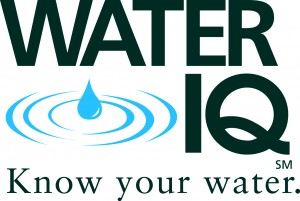Water Conservation Tips
20 Ways to be Water Smart
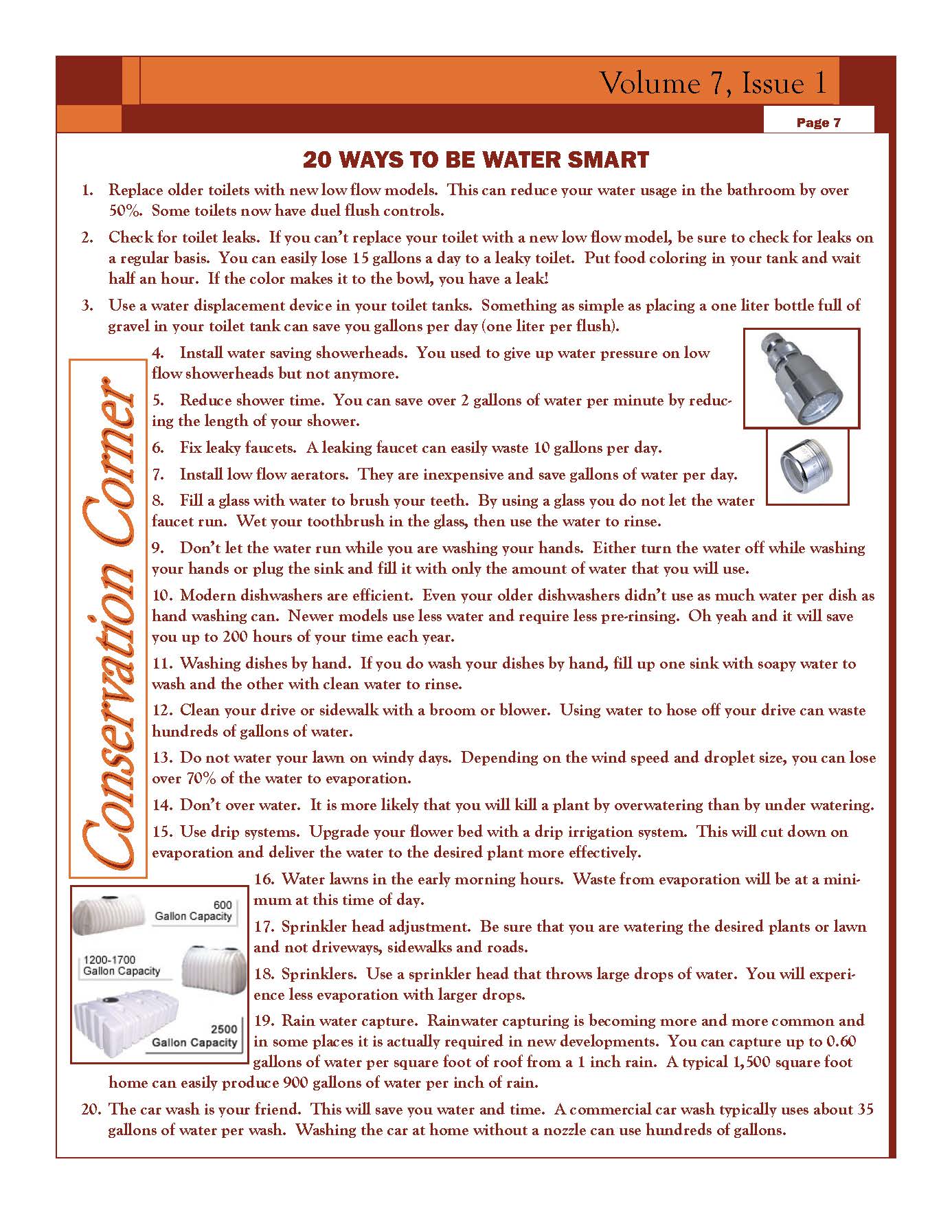
Outdoor Water Conservation Tips
Finally, spring has spring and summertime is on the way, and that means our water use is going to skyrocket. It is estimated that during the summer we use between two and four times as much water as we do the rest of the year. Overall, depending on where you live and how much watering you do, 30 — 70 percent of all the water we use at home is used outdoors. The best way to be sure you aren’t wasting water is to follow some simple guidelines. If you don’t, you may be wasting up to 50 percent of the water you are using outdoors due to inefficient watering methods and evaporation. Keep these tips in mind when you are using water outdoors:
Don’t water your lawn or garden at the wrong time of the day. During the hottest part of the day you can lose a significant amount of the water you are applying to evaporation.
Water the lawn only when it needs it. Most lawns only need one inch of water each week. Pay attention to the weather and keep a rain gauge in the yard to help you monitor how much water you are getting. If you are planting a new lawn consider drought tolerant varieties such as Buffalo grass, Bermuda grass, and some varieties of St. Augustine grass. These varieties will go dormant during a drought and recover well when the rains begin again.
One way to tell if your lawn needs water is to step on the grass and see if it springs back. If it does you needn’t worry about watering. Also, let the grass grow a little. By letting it grow longer it will shade the ground and roots and slow the evaporation rate.
In the garden, be sure to utilize mulch around your vegetable plants. A good layer of ground cover will allow the water to seep deeper into the soil and reduce loss due to evaporation.
Pools are very susceptible to evaporation, up to an inch and a half per day. It’s not uncommon to have to add 2,000 gallons a month to a pool due to evaporation. The use of a pool cover can reduce evaporation by as much as 90 percent.
Another way to conserve water and reduce your water bill is to install a rain collection system and/or a drip irrigation system. These two systems alone or in tandem can save you thousands of gallons of water from your water bill. Both of these options can be kept simple or made as high tech and complex as you would like.
There are a variety of ways to collect rainwater from the roof of your home or barn to use at a later date when you need it to water your ornamentals or your vegetables. The simplest way to get started with a rainwater collection system is to simply put a cleaned barrel that has a spigot located near or on the bottom of the barrel (if on the bottom barrel must be raised) under a gutter downspout. You will collect approximately 0.6 gallons of water per square foot of roof surface. Keep just one barrel near your flower bed and when it gets dry out, you’ll be ready to go.
With a drip irrigation system you will be able to apply a very specific amount of water to each plant individually when you water. You can purchase a basic all inclusive set-up at your local home improvement store for $50—$75. The starter kits typically come with a variety of components and between 50—100 feet of tubing to get you started.
Water wisely – every drop you save counts! Even though we seem very wet right now, remember just a few summers ago we experience a severe multi year drought. Develop good habits now to conserve water and it will be less painful when the next
drought occurs.
Water Conservation Tips 2016
Using water, specifically groundwater (which provides 60 percent of the water used in Texas ), more efficiently will not only save money but, more importantly, will protect the quality of life of current and future Texans. With the vastness of Texas, it’s easy to forget two important facts about our state: 1) we are subject to frequent droughts and, 2) our population is projected to nearly double in the next 50 years. To ensure that we have enough water, we need to reduce the amount of water we waste. A few small changes in your water use habits can make a huge difference in water savings.
Using efficient showerheads and aerators on your faucets can significantly reduce the amount of water you use. In fact, installing an efficient showerhead is one of the most effective water saving steps you can take inside your house. Also, you can save a little more water by getting into the shower as soon as possible—don’t let the water run too long while warming it up.
When possible, update and replace old toilets, washing machines, and dishwashers. New efficient models can save you thousands of gallons per year.
An older clothes washer will use up to 23 gallons per load, whereas a new energy efficient model may use as little as 13 gallons. Considering that the average household washes about 300 loads per year, the numbers add up quickly. Another thing to keep in mind is that if you wash with hot water, up to 90% of the cost to wash those close is simply for heating the water. Only use hot water when necessary so you’ll save on your electrical bill and reduce the impact on the water-energy nexus (a complex relationship between the production of electricity and water).
In the kitchen, a water efficient dishwasher can save over 1,000 gallons of water per year. Keep in mind, 1,000 gallons per home may not seem significant, but multiply that by a neighborhood and 1,000 gallons per home will add up to quite a lot. Newer
machines have more effective water jets and sensors that will do a better job with less water. And for those tough dishes, let them soak in some water instead of trying to scrub them clean with running water.
Newer water efficient toilets will use only about 1—1.5 gallons of water per flush. And be sure that you keep aware for any leaks. A leaking toilet can waste quite a bit of water, possibly thousands of gallons a month in extreme cases. It is estimated that 10% of all homes in the U.S. have water leaks wasting 90+ gallons of water per day.
Outdoors, planting well adapted and/or native shrubs, trees, and grass is key to watering efficiently. Drought and heat tolerant species can survive cool winters and dry summers, saving not only water but your time and effort due to lower maintenance
requirements.
Also, be sure that you water at the right time of day. It is estimated that watering during the hottest time of the day will waste 20% - 25% percent of the water due to evaporation. Prevent this by watering in the morning (before 11:00 a.m. is
recommended). Also avoid watering on windy days as this will significantly increase the amount of water loss due to evaporation. Drip irrigation systems are a great way to
water plants and shrubs efficiently with a minimal amount of water. Combined with proper bedding/mulching, this can save you hundreds, if not thousands, of gallons of water each summer and, if you add a timer to the system your plants will require less personal attention.
As for your lawn, taller grass holds moisture better. Refrain from cutting off more than 1/3 of its length at one time. During a drought many grasses will go dormant, so learn more about your grass and you may find that you do not need to water it at all.
One last note, for those of you who live in an area with a homeowner association, in 2013 the Texas Legislature passed Senate Bill 198. Homeowner association may require approval of any changes to landscaping, but S.B. 198 prohibits an association
from restricting a property owner’s decision to make water-wise landscape choices.
Summertime Water Saving
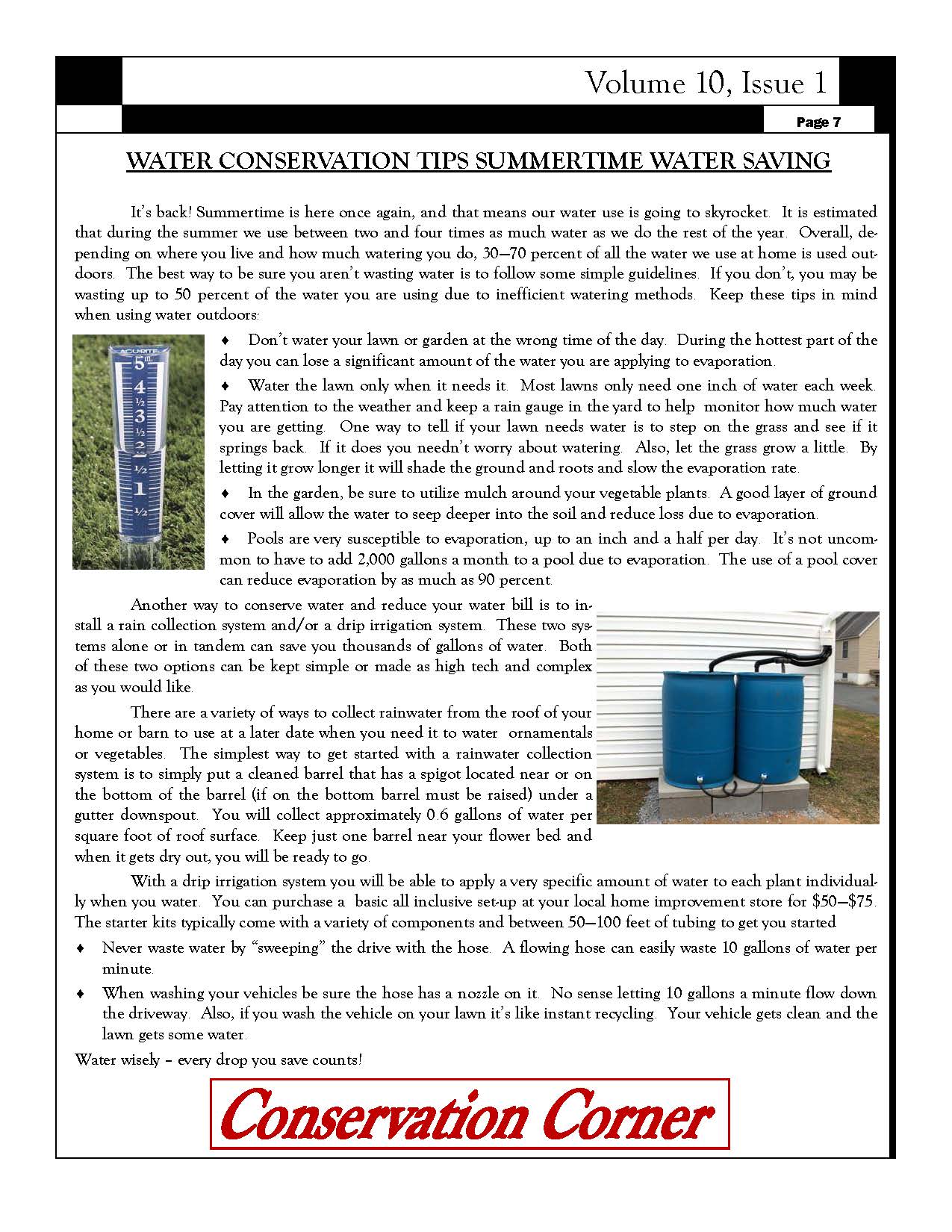
Winter Conservation Tips
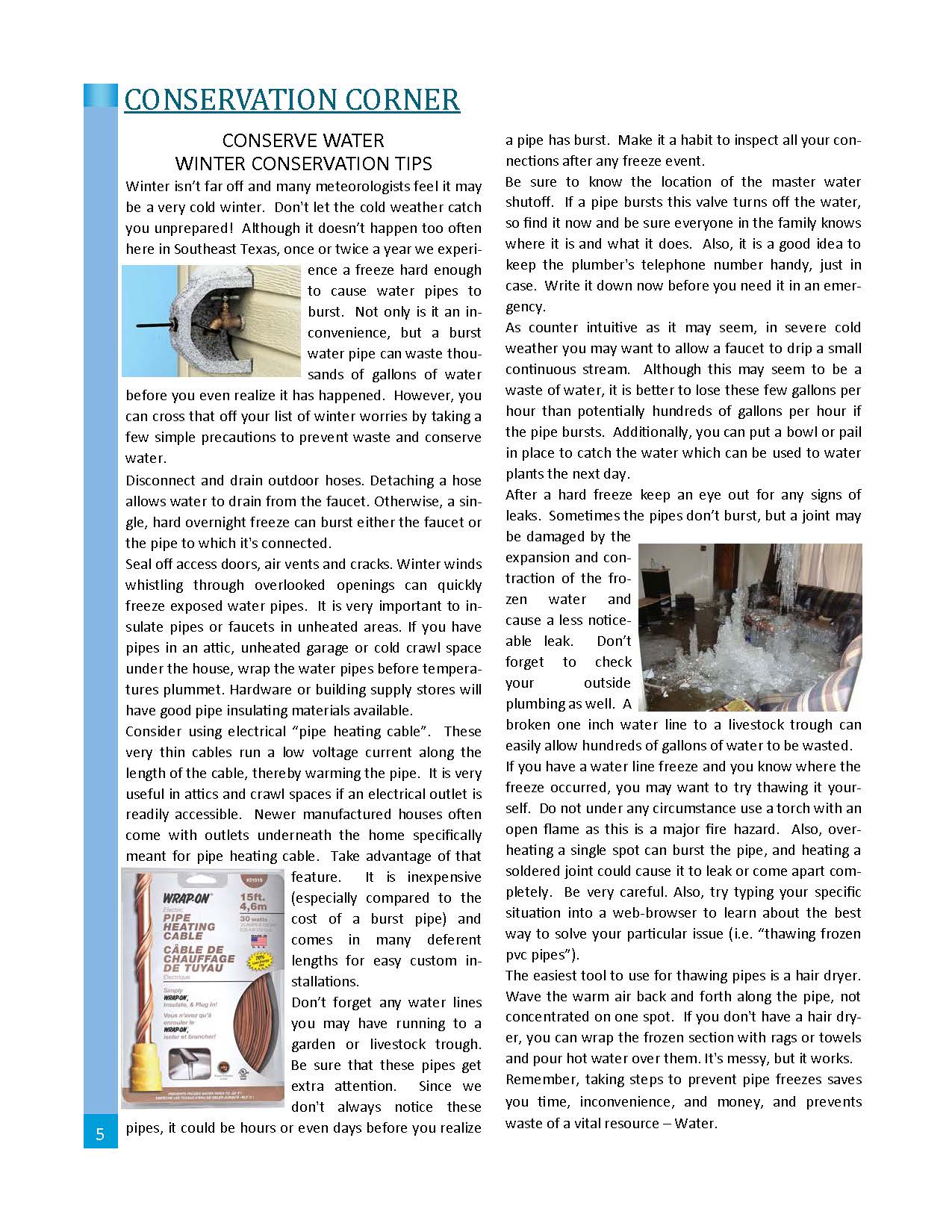
How Not To Waste Water
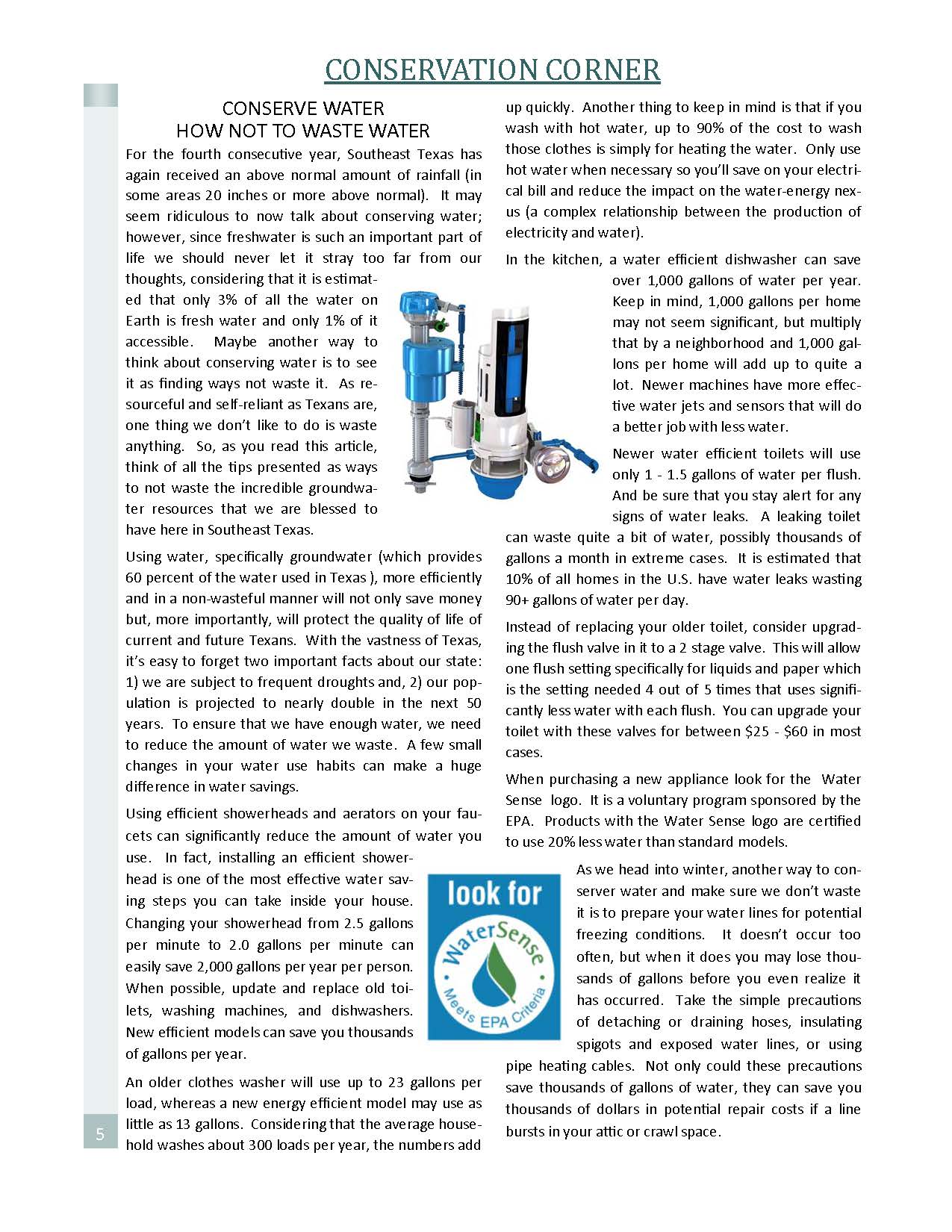
Every Drop Counts
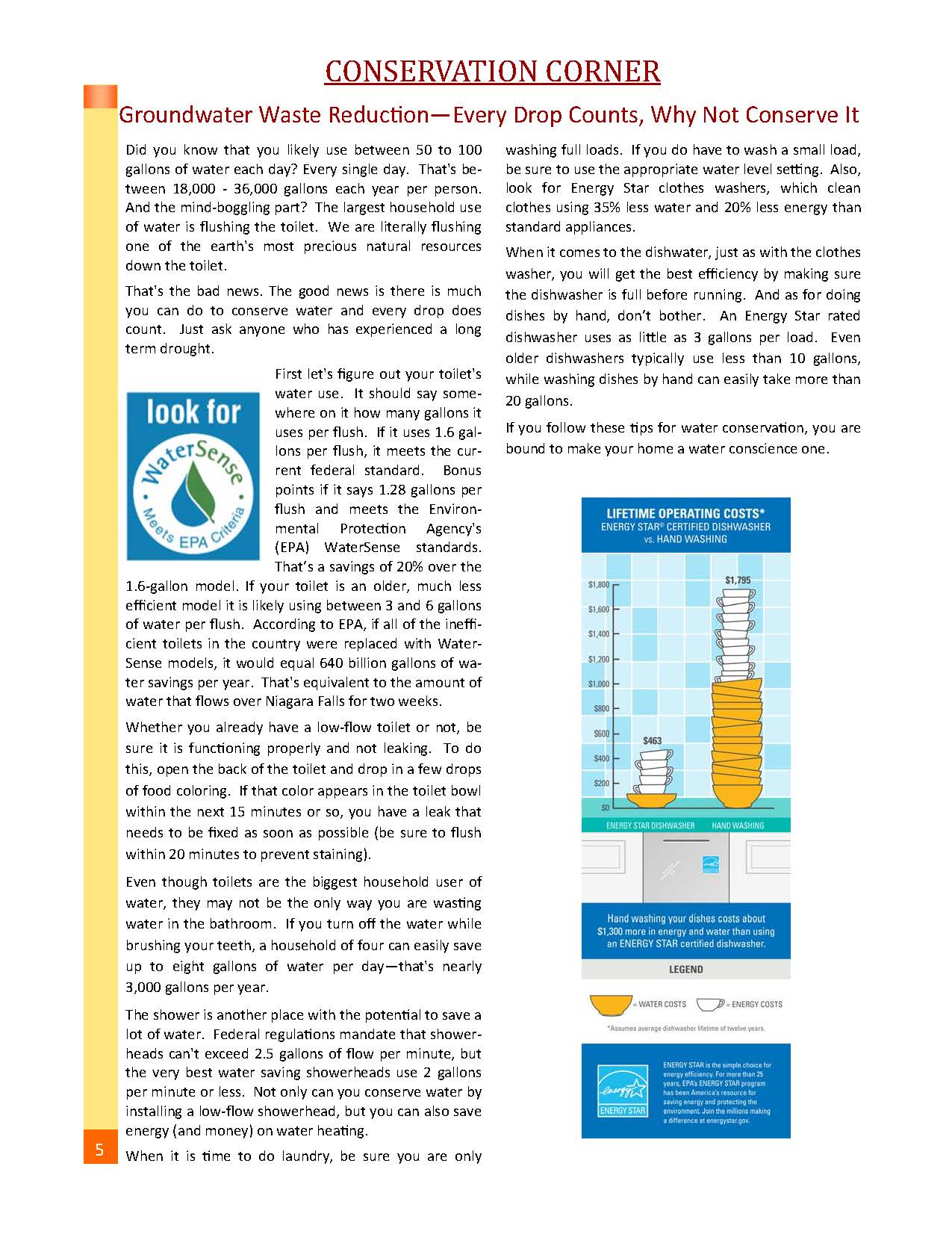
Water Footprint - You're Using More Than You Think
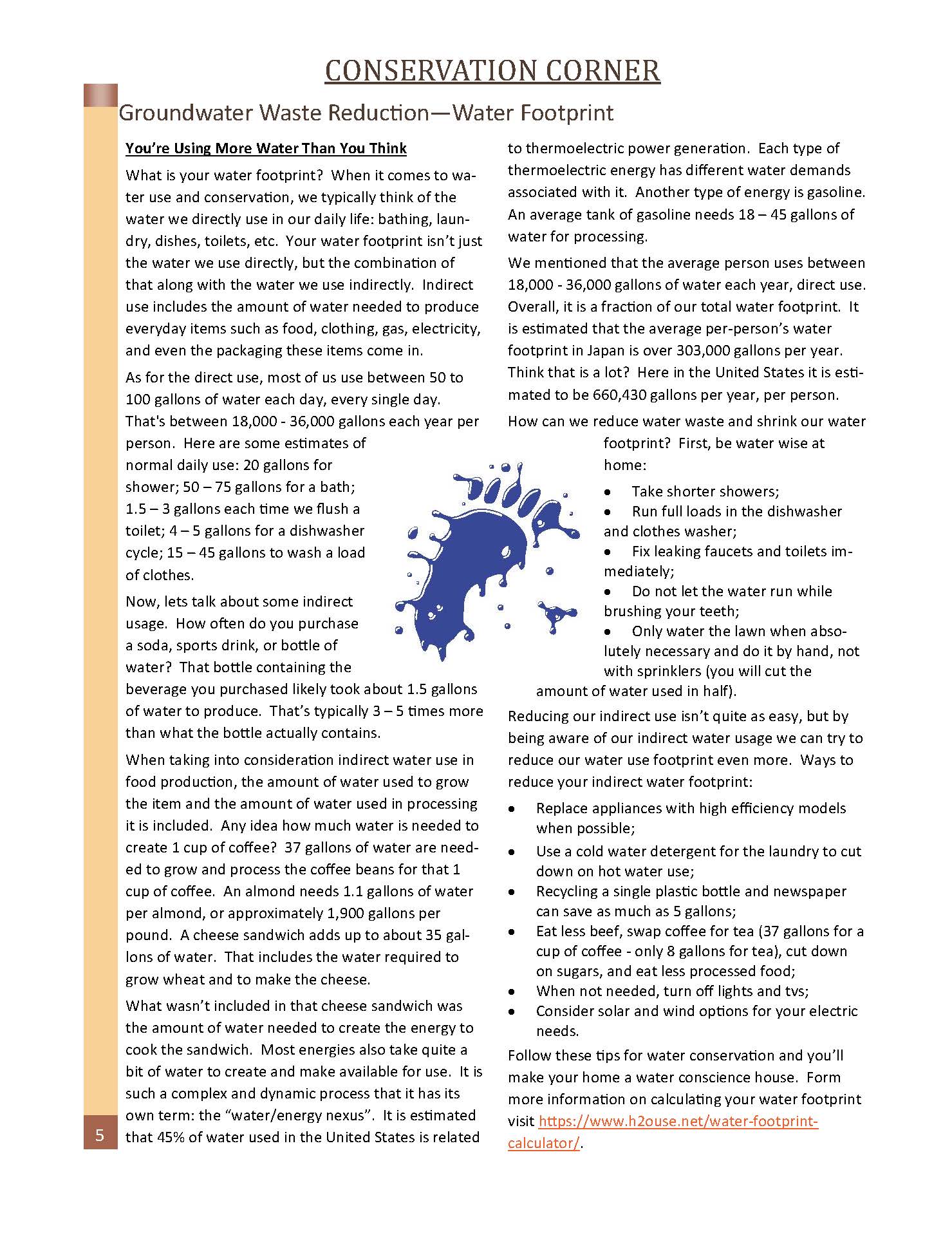
Drought Preparedness - Conserve Now Before You Have To
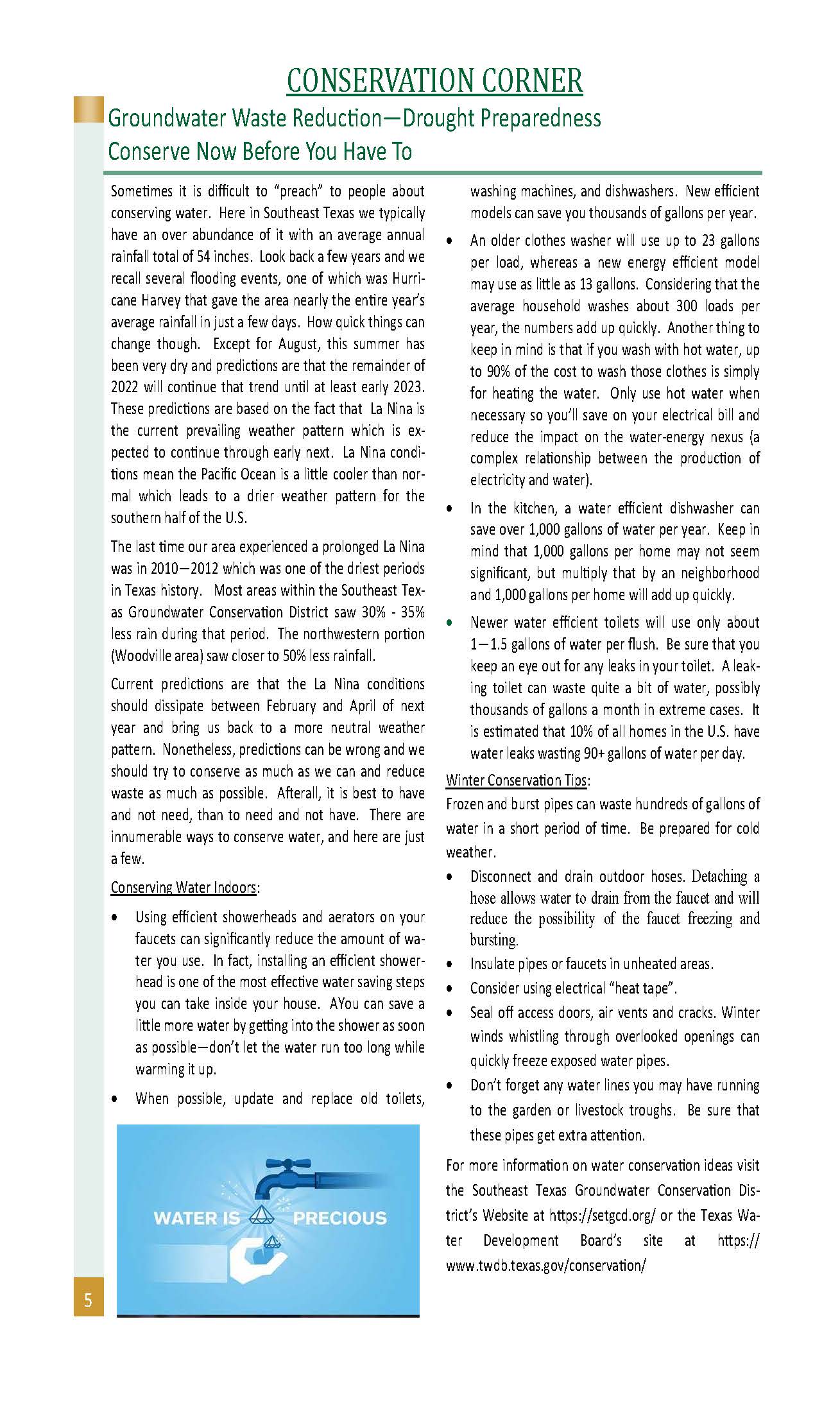
Plan Ahead: Conserve Water - Reduce Summertime Waste
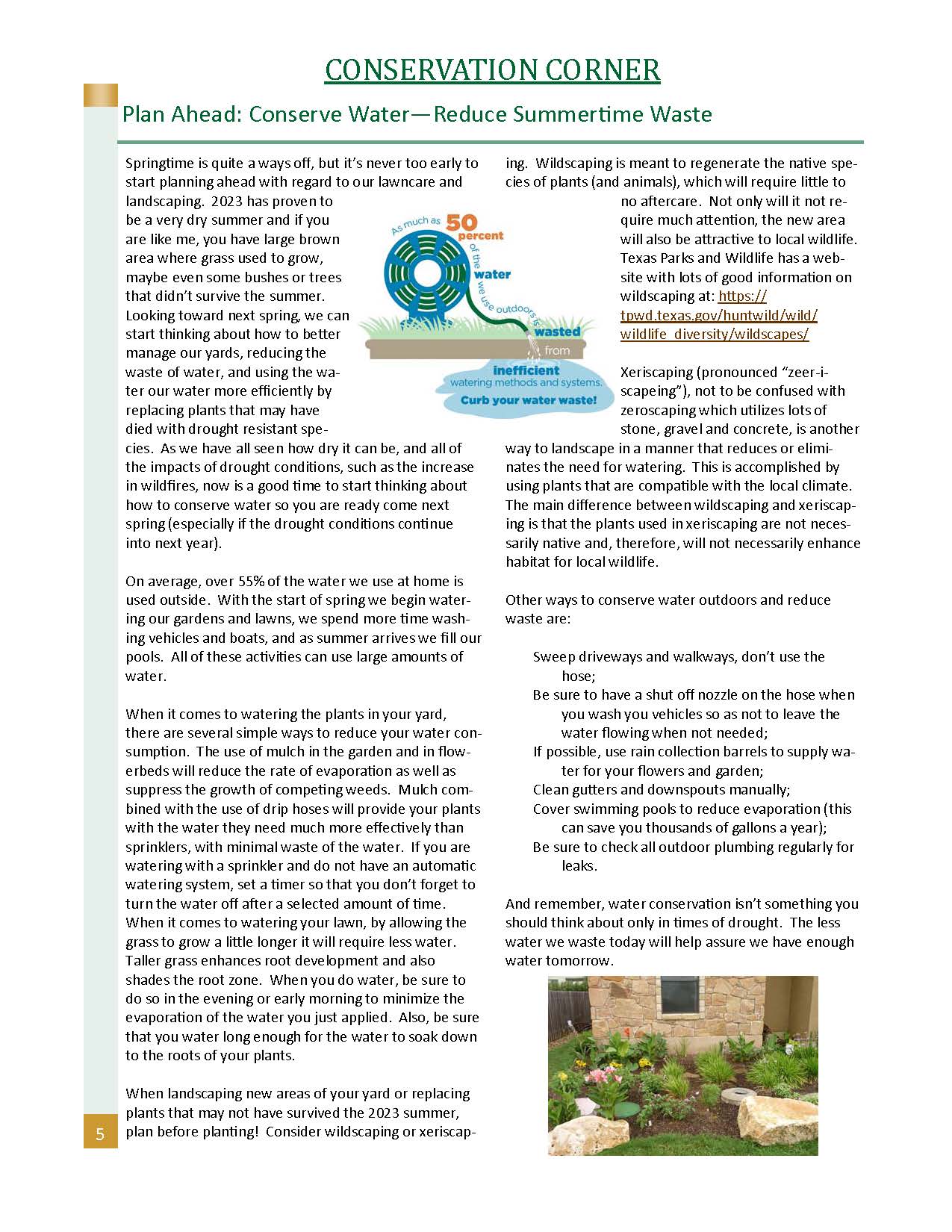
Drought Preparedness - Reduce Wasteful Practices to Bank Water for Future Use
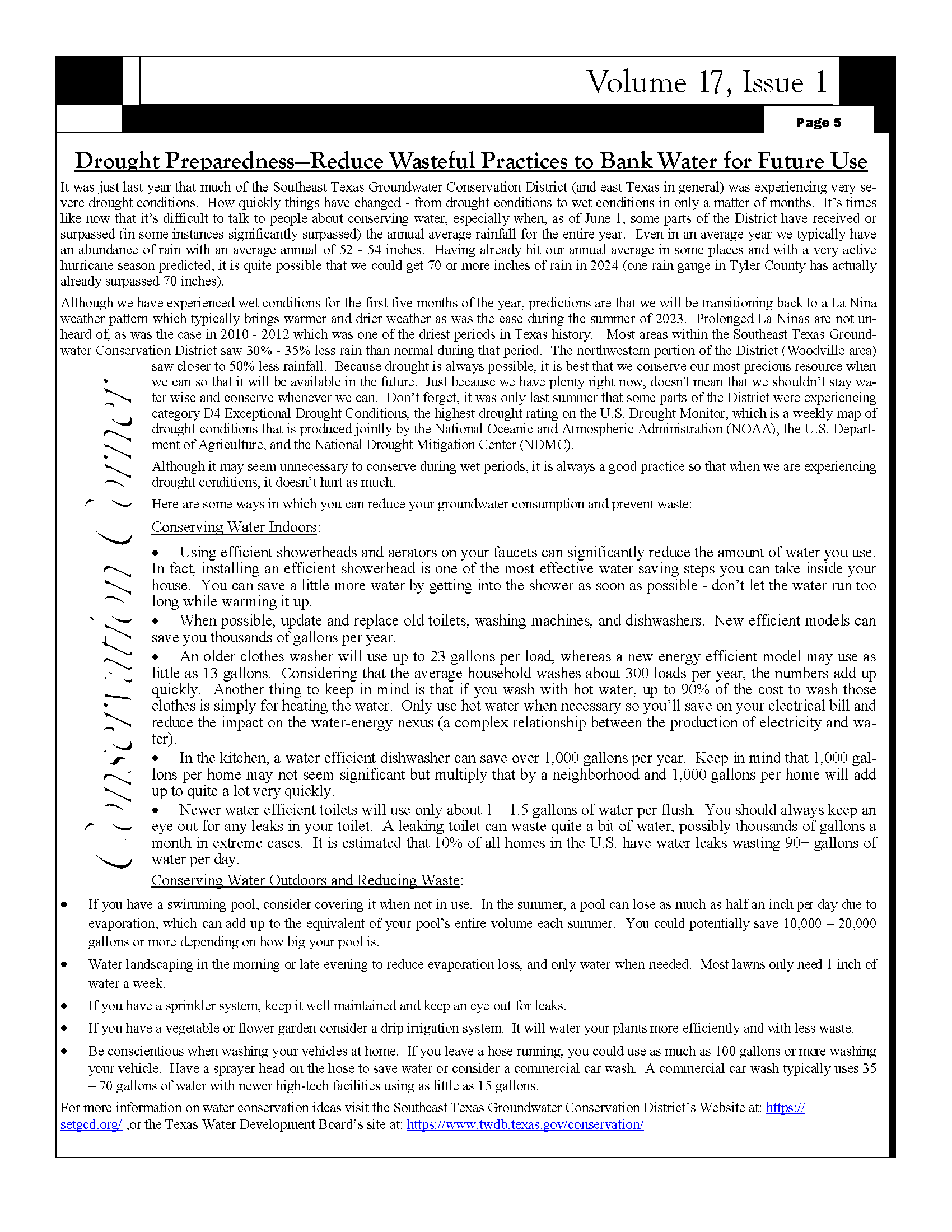
Summertime Groundwater Conservation and Waste Reductions Tips 2025
Summertime Groundwater Conservation and Waste Reduction Tips
We are just barely seeing signs of spring but before we know it, summertime will be here once again. That means our water use is going to increase significantly. It is estimated that during the summer we use between two and four times as much water as we do the rest of the year. Overall, depending on where you live and how much watering you do, 30—70 percent of all the water we use at home is used outdoors. The best way to be sure you aren’t wasting water is to follow some simple guidelines that will help conserve our most precious resource. If you don’t, you may be wasting up to 50 percent of the water you are using due to inefficient watering methods. Since nearly all water used within the Southeast Texas Groundwater Conservation District is groundwater (well water), by conserving water today, we are banking it for future use when we experience drought periods. Keep these tips in mind when you are using water outdoors:
• Don’t water your lawn or garden at the wrong time of the day. During the hottest part of the day, you can lose a significant amount of the water you are applying to evaporation.
• Water the lawn only when it needs it. Most lawns only need one inch of water each week. Pay attention to the weather and keep a rain gauge in the yard to help you monitor how much water you are getting.
• One way to tell if your lawn needs water is to step on the grass and see if it springs back. If it does, you needn’t worry about watering. Also, let the grass grow a little. By letting it grow longer it will shade the ground and roots and slow the evaporation rate.
• In the garden, be sure to utilize mulch around your vegetable plants. A good layer of ground cover will allow the water to seep deeper into the soil and reduce loss due to evaporation.
• Pools are very susceptible to evaporation. It’s not uncommon to have to add 2,000 gallons a month to a pool due to summertime evaporation. The use of a pool cover can reduce evaporation by as much as 90 percent. And, believe it or not, even during the winter season you can lose hundreds of gallons per month to evaporation if the pool is not covered.
• Pool features such as fountains have become popular. These fountains look great, but they can significantly increase the amount of water you lose to evaporation. Save water by limiting the runtime of these fountains or eliminate it all together.
• Be conscientious when washing your vehicles at home. If you leave a hose running, you could use as much as 100 gallons or more washing your vehicle. Have a sprayer head on the hose to save water or consider a commercial car wash. A commercial car wash typically uses 35 – 70 gallons of water with newer high-tech facilities using as little as 15 gallons.
Another way to conserve water and reduce your summertime water consumption, and your water bill if you are on a public system, is to install a rainwater collection system and/or a drip irrigation system. These two systems alone or in tandem can reduce your water usage by thousands of gallons. Both of these two options can be kept simple or made as high tech and complex as you would like.
There are a variety of ways to collect rainwater from the roof of your home, workshop, or barn to use later when you need it for watering your ornamentals or your vegetables. The simplest way to get started with a rainwater collection system is to put a thoroughly cleaned barrel that has a spigot located near or on the bottom of the barrel (if on the bottom barrel must be raised) under a gutter downspout. You will collect approximately 0.6 gallons of water per square foot of roof surface. Keep just one barrel near your flower bed and when they need watering, you will be ready to go.
With a drip irrigation system you will be able to apply a very specific amount of water to each plant individually when you water. You can purchase a basic all-inclusive set-up at your local home improvement store for $50—$75. The starter kits typically come with a variety of components and between 50—100 feet of tubing to get you started.
For more information on water conservation ideas visit the Southeast Texas Groundwater Conservation District’s Website at: https://setgcd.org/ ,or the Texas Water Development Board’s site at: https://www.twdb.texas.gov/conservation/

